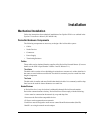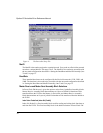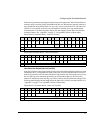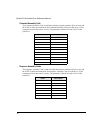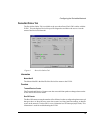
13
Configuring the DeviceNet Network
the position controller profile positions, velocities, accels, and decels can be written for a
single index. The index can then be initiated. The Position Control object is used heavily
when a central PLC is desired to control all of the Slaves. This type of configuration allows
for quick parameter changes. The following tables display the data mapping for the Position
Control Assembly Blocks. See “Appendix” on page 71 for expanded versions of these tables
Master Receive Assembly Block - Position Control
Master Send Assembly Block - Position Control
No Operation
The No Operation Assembly Block is used when the user only needs to read back data. This
assembly block allows the user to put any data into the corresponding PLC address without
affect from the drive. This type of assembly block is used heavily in applications when the
PLC is explicit messaging.
Master Send Assembly Block - No Operation
Word Bit 15 Bit 14 Bit 13 Bit 12 Bit 11 Bit 10 Bit 9 Bit 8 Bit 7 Bit 6 Bit 5 Bit 4 Bit 3 Bit 2 Bit 1 Bit 0
0 Reserved Reserved Reserved Reserved Reserved Reserved Reserved Reserved
Enable
State
Valid
Data = 1
Ignore
Data = 0
Absolute
Position
Valid
Stop
Input
Fault
End of
Index
Motion
Reserved
Trajectory
Started
1 Reserved Reserved Reserved Response Assembly Code (See page 16)
Command
Error
Reserved
Trajectory
Start Echo
Reserved Reserved
CCW
Hardware
Limit
(Travel
Limit -)
CW
Hardware
Limit
(Travel
Limit +)
Drive OK
2 Data Low Word LS Bit
3MS Bit Data High Word
Word Bit 15 Bit 14 Bit 13 Bit 12 Bit 11 Bit 10 Bit 9 Bit 8 Bit 7 Bit 6 Bit 5 Bit 4 Bit 3 Bit 2 Bit 1 Bit 0
0 Reserved Reserved Reserved Reserved Reserved Reserved Reserved Reserved Enable
Va l i d
Data = 1
Ignore
Data = 0
Reserved Stop Reserved
Absolute=0
Incremental=1
Reserved
Start
Trajectory
1 Reserved Reserved Reserved Response Assembly Code (See page 16) Reserved Reserved Reserved Command Assembly Code (See page 16)
2 Data Low Word LS Bit
3MS Bit Data High Word
Word Bit 15 Bit 14 Bit 13 Bit 12 Bit 11 Bit 10 Bit 9 Bit 8 Bit 7 Bit 6 Bit 5 Bit 4 Bit 3 Bit 2 Bit 1 Bit 0
0
1
2
3



